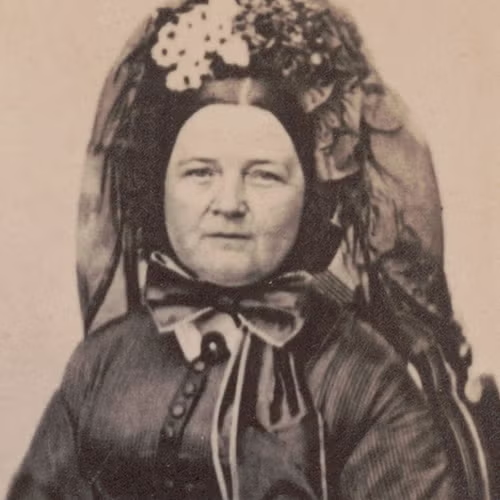
Table of Contents
Who Was Mary Todd Lincoln?
Mary Todd Lincoln, the wife of the 16th President of the United States, Abraham Lincoln, became a prominent figure in American history. Born into a wealthy and politically active family in Lexington, Kentucky, she married Abraham Lincoln on November 4, 1842. Despite the challenges and personal tragedies she faced throughout her life, Mary Todd Lincoln was a staunch supporter of her husband’s political career, especially during the turbulent times of the Civil War. However, her life was marked by deep personal grief and public scrutiny, which ultimately led to her temporary commitment to an asylum after the death of her husband and child.
Early Life
Mary Todd Lincoln was born on December 13, 1818, in Lexington, Kentucky, into a distinguished family. Her father, Robert Todd, was a successful merchant and politician. Tragically, Mary lost her mother at the young age of six. Her father remarried, but her relationship with her strict stepmother was strained. Despite these challenges, Mary received an exceptional education for a young girl of her time, attending both a local academy and a boarding school.
In the late 1830s, Mary moved to Springfield, Illinois, to live with her sister Elizabeth Edwards. There, she became well known for her intelligence and outgoing nature, attracting admirers, including Stephen Douglas and Abraham Lincoln, a young lawyer and politician. Despite significant disapproval from her family—who found the match unappealing due to Abraham’s modest background and limited education—Mary and Abraham formed a deep connection, bonded by a shared interest in politics and literature. The couple married in 1842, and soon after, they had their first son, Robert Todd Lincoln.
The Lincolns welcomed a second son, Edward, in 1846, and Mary was an active supporter of her husband’s political career. She advised him, hosted events, and advocated for his advancement. When Abraham won a seat in Congress, Mary took an active role, even accompanying him to Washington for part of his term. Their partnership was strong, and in 1860, upon learning of Abraham’s successful presidential election, he rushed home exclaiming, “Mary, Mary, we are elected.”
First Lady
When Abraham Lincoln was elected President in 1860, the country was on the brink of the Civil War. As Southern states seceded from the Union, Mary’s Kentucky roots put her in conflict with her social circle, many of whom supported the Confederacy. However, Mary remained a passionate and unwavering Unionist. Her time as First Lady was marked by controversy and hardship. She was widely disliked in the White House for her emotional nature, outspoken opinions, and lavish spending during a time of war and national financial strain. Some even accused her of sympathizing with the Confederate cause, though these claims were never substantiated.
Her years in the White House were also filled with personal sorrow. In 1850, the Lincolns lost their young son Edward to tuberculosis. Then, in 1862, their third son, William (Willie), succumbed to typhoid fever. Mary’s grief following Willie’s death was profound, leaving her emotionally devastated and deeply concerned about her own mental well-being. Her interest in spiritualism during this period, while an attempt to communicate with her deceased children, was also widely criticized.
On April 14, 1865, Mary’s life was further shattered when her husband was assassinated while they were attending a play at Ford’s Theatre. Abraham Lincoln died the following day, and Mary never fully recovered from the trauma of his loss. She returned to Illinois, but the death of her youngest son, Thomas, in 1871, plunged her into even deeper despair.
Later Life and Mental Health Struggles
In 1875, Mary’s surviving son, Robert Todd Lincoln, took legal action to have her committed to an asylum, citing concerns over her mental health. He alleged that her extravagant spending, distorted financial perceptions, and erratic behavior indicated that she was unfit to care for herself. The court sided with Robert, and Mary was temporarily placed in a mental institution. After several months, she was released, but the incident contributed to her estrangement from her son and left a lasting mark on her public image. She was often portrayed as mentally unstable, a perception that lingered throughout her later years.
Despite her personal struggles, Mary Todd Lincoln’s legacy remains intertwined with the tumultuous events of the Civil War and the assassination of her husband, marking her as one of the most complex and tragic figures in American history.
Final Years and Death
In 1876, Mary regained control over her property after a court determined her to be of sound mind. Fearing that her son might attempt to have her institutionalized again, she chose to live abroad. In 1881, however, she returned to the United States and settled with her sister, Elizabeth, in Springfield, Illinois. Mary passed away from a stroke on July 16, 1882, at the age of 63.
Historians have long debated various aspects of Mary’s character, particularly her mental health. While she certainly exhibited a high-strung personality, tendencies toward compulsive shopping, and an interest in unconventional ideas, she also demonstrated a sharp mind and wit, challenging the perceptions of her sanity over time.
